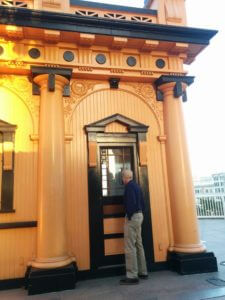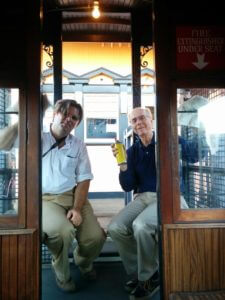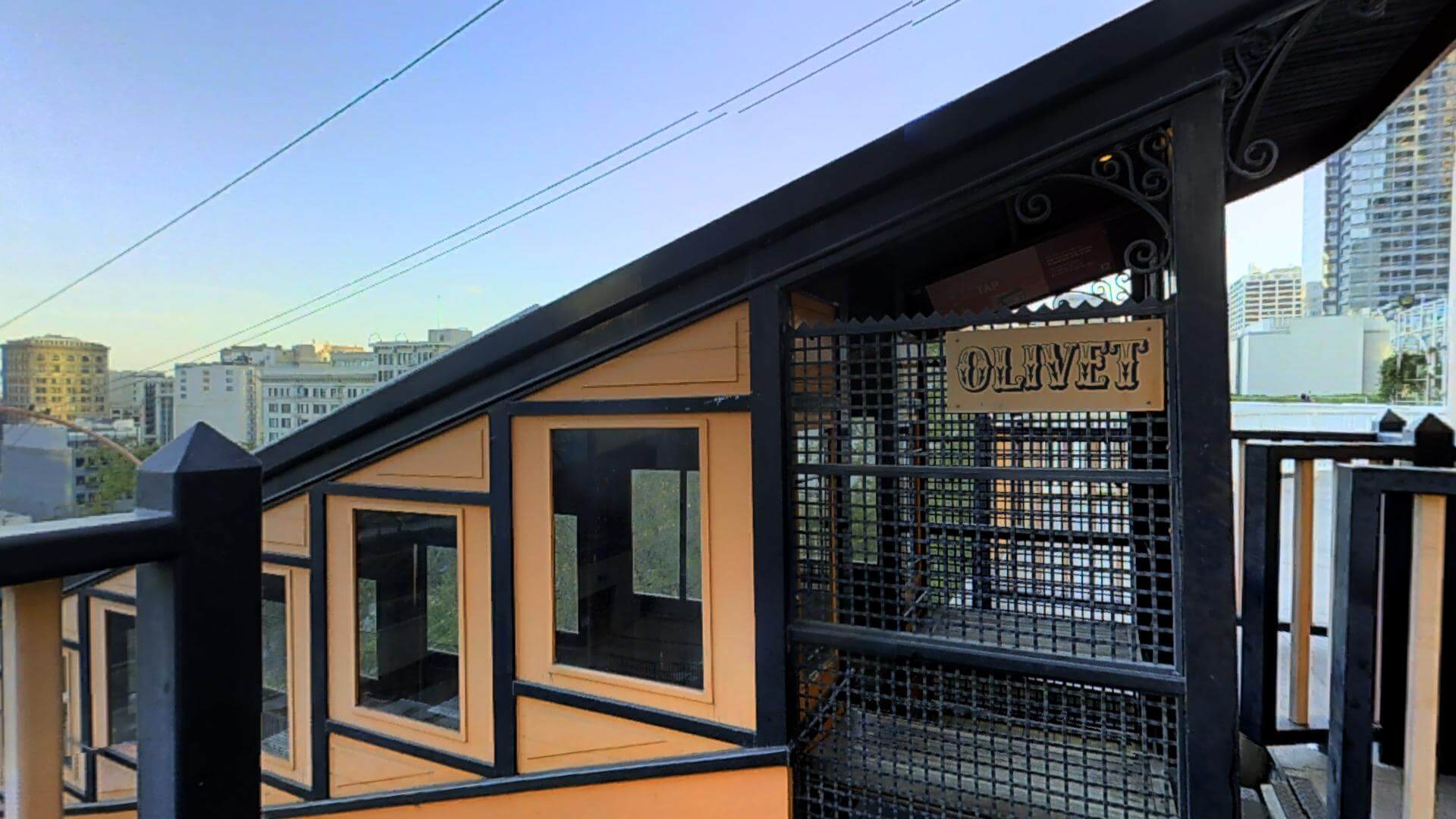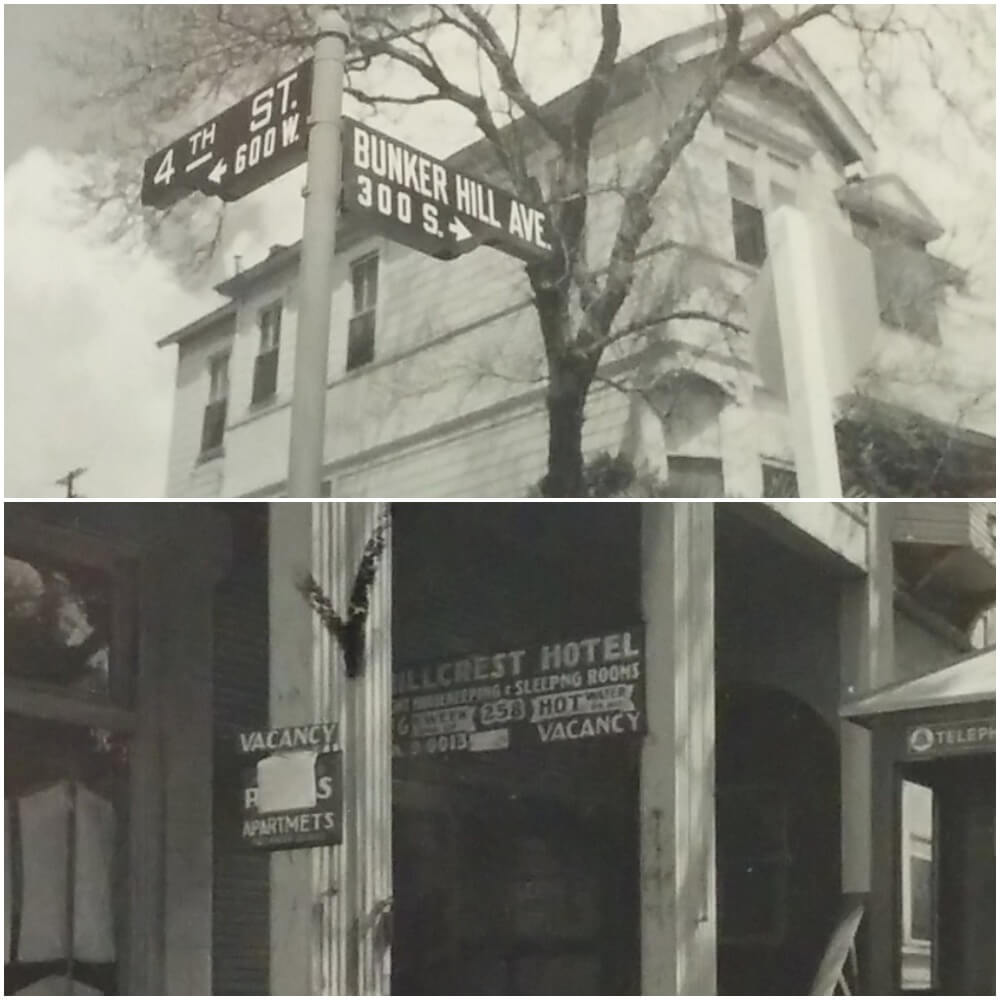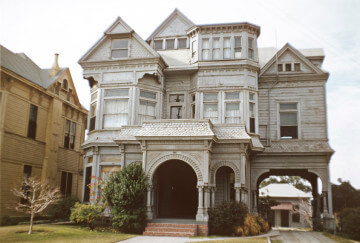Come walk with me on Bunker Hill. I don”™t mean now, for we won”™t pass California Plaza or Wells Fargo Center. We won”™t see MOCA or Disney Hall. We will see Angels Flight, but it will be on the corner of 3rd Street and Hill next to the tunnel, and it will be running, so we can take a ride. I mean come with me to my Bunker Hill, the old Bunker Hill, the one where I lived in the 1940”™s, 50”™s, and 60”™s when it was a residential area. Of course, Bunker Hill was much older than that. It was developed in the late 19th Century when its lovely old Victorian buildings were built. That was its charm. Every building was different, all with intersecting angles, curved verandas, and turrets, domes, carved details, light and shadows. And they all had names like the Chaspeak, the Argyle, the Nugent, the Lovejoy, the Melrose, the Salt Box, and the Castle.
Board Angels Flight with me as we so often did on shopping trips to downtown. Sit next to me in my seat, the open one at the back of Sinai or Olivet where I always sat. Our fellow passengers are my neighbors. In the morning or early evening they would be people commuting between their homes on Bunker Hill and their jobs downtown. Other times they might be mothers with their children on their way to shop downtown just like my mother and I did at Grand Central Market or the department stores and myriad other shops. In the evening, there would be couples going to see a movie at one of the movie palaces down on Broadway. Many passengers are elderly residents of Bunker Hill who were called “pensioners” at the time. Today we would call them the elderly poor, for Bunker Hill in those days had become the home of lower income residents. It was also home to many artists and writers as well as a large number of first generation immigrants from Europe and South America. They all lived there because that”™s where they could afford to live and because most all your needs could be met within walking distance. Many residents didn”™t own cars, they didn”™t need them.
On our way up Bunker Hill on Angels Flight we pass the Sunshine Apartments where Burt Lancaster, Dan Duryea, and Yvonne De Carlo plotted the armored car robbery in the movie Criss Cross.”™ As we get off the car at the top, remember to put your nickel, or your ticket if you are a regular rider and bought a ticket book, in the slot at the station house where the operator of the world”™s shortest railway sat wearing his railroad cap. Nice fellow, but didn”™t talk much. Now we cross Olive Street and walk West up 3rd Street through the small commercial area. We pass a café, a shoe repair, a laundry, the Budget Basket market, and Angels Flight Pharmacy. Maybe we stop in to purchase something or just to talk to the grocer or the pharmacist. Maybe we buy a newspaper from the one armed man who runs the newsstand there at 3rd and Grand.There are always a couple of neighborhood locals sitting on milk crates smoking cigarettes chatting with him and passersby.
Now let”™s cross Grand Avenue and go cattycorner to the Nugent Delicatessen. Because this a hot August day, I like to stop in and get a bottle of Pepsi Cola from the cooler. Somehow, it”™s the best Pepsi I ever had and it”™s only 10 cents. Dick Powell thought so, because he walked in there in the movie, Cry Danger”™ right past the cooler with the bottles inside.
Now we walk up the short hill to where 3rd Street dead ends at South Bunker Hill Avenue. There is a little park on the West side of the street where the benches are filled with elderly gentlemen of the neighborhood feeding the pigeons, playing chess, reading the papers, and discussing the ways of the world. Even on this hot day they are all dressed in suits with ties and wearing hats. As we stand there looking West, on our right is the Alta Vista Apartments where another of our neighbors, the writer John Fante (and his alter-ego, Arturo Bandini), lived some of his best loved, if impoverished, days.
Now let”™s turn and head south on South Bunker Hill Avenue because we are almost home to my house, the “Castle.” My grandmother bought it and the Victorian next door in 1937 and my father inherited them when she died. Her brother, Mickey, owned the “Salt Box” next door. Another brother, Laurence, owned the Crestholme down on the corner of 4th and South Bunker Hill Avenue. The “Castle” was a beautiful 3 story Victorian built in the 1880”™s when Bunker Hill was the home of Los Angeles”™ elite. Soon after the turn of the 20th Century, it became a rooming house when the neighborhood changed. We rent out rooms to our tenants, most of whom are elderly. As we get to the “Castle,” we turn and go up the walk, climb the front stairs and cross the veranda to the stained glass double front doors. Turning the cast iron door knob, we go through to the front entry hall, under the chandelier, past the grand staircase and into the front parlor. I am home in the benevolent embrace of this grand old Victorian. Like all the other Victorians on Bunker Hill, it had a quiet dignity and timelessness that I miss.
Bunker Hill was a mature, quiet urban neighborhood with well-tended yards. It was not the “blighted slum” that propaganda of the time said it was. Instead, it was a tranquil oasis above the busy city down below. If I still lived in the Castle, I”™d invite you in. But I don”™t live there anymore. In fact, none of us who once made up this neighborhood community lives there now because Old Bunker Hill was ripped from the heart of Los Angeles 50 years ago. Before too many more years, it will pass from Los Angeles”™ living memory. But Old Bunker Hill isn”™t really gone. Instead, it floats ethereally in memory and in our hearts above Hope and Grand, Olive and Hill.
